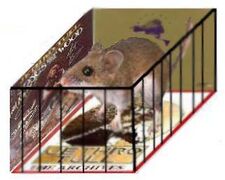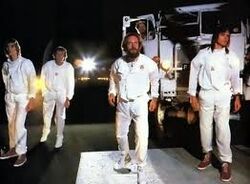Jethro Tull
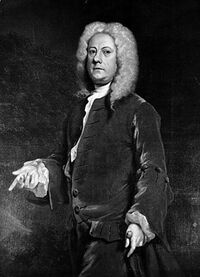
“Galliards, and lute songs served in chilling ale!”
Originally, Jethro Tull was the name of a respected 16th century agriculturist who brought forth radical and important new ideas in the form of inventions such as the seed drill. He was admired and respected for centuries as a truly gifted and creative inventor, and his name was fondly remembered by hundreds of agriculturists across England. Then, in the late 1960s, a small and unpopular British blues band made one of the most fateful decisions in the history of rock and roll; they named themselves after this famous man, and subsequently became famous themselves, ruining the name of the agricultural genius for all time.
Jethro Tull was founded by musical prodigy and avid bookworm Ian Anderson, who felt that his bold new nasal-oriented singing style would fare well in another British blues band. Enlisting the help of some friends, he set out to shock the world with rich musical flavors and stunning progressive rock masterpieces (although he would have to get rid of a few non-believers along the way). Tull ended up being considered one of the best progressive rock acts of all time, and this was a tremendously important achievement for the band until the 1980s appeared. After slowly puttering out of the major music scene, they finally came to rest as a unique world music/prog rock/electronic/whatever group and continue to tour the few cities that still appreciate them the world to this day. In fact, as we speak, Ian Anderson is currently beginning work on Thick as a Brick 3: Gerald Bostock Reloaded.
History[edit]
1967–70: Early years[edit]
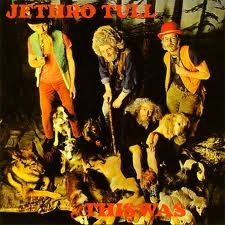
The band began as an attempt by Ian Anderson to create an audio sensation to sweep the nation. He had developed an interest in music after being introduced to the famed Scottish Bagpipe Band of Fellowes as a teenager. At one of the performances he was so moved that he felt he simply had to try and create a sound as beautiful as he had heard, on his very own. Eventually, Anderson formed a small blues band with some lads from the local pub and started his long musical journey. The band slowly gained momentum, and went through enough bad band names to amaze even Creedence Clearwater Revival. After a few years of no success, dirty pubs, and over forty different name changes, the band was almost ready to quit music all together. That is, until a very creative manager gave them their horrible yet game-changing new name: Jethro Tull. Somehow it worked, and by the next month the band had a nice little record out, complete with its very own typo (the single bore the name Jericho Toe, a mistake later blamed on Anderson's personal tea-boy).
After this, the band began their upward rise to fame. Anderson had already begun to experiment with the flute, which he had previously played around with in his school's band camp. This new instrument delighted audiences, and gave Anderson an even better way to use his golden voice; by making strangled snorting sounds and effectively coating the members of the audience in the front row in saliva. Tull's boldness was shown early; one of their early singles, "Running from the Past", was written in 5/4 time. This kind of audacity from a simple rock group was unheard of at the time, and had classical music listeners sputtering loudly in outrage.
The band's debut album This Was, with its stunningly vibrant album cover, flew straight to #10 in the UK charts. This massive success for such a small band had the group elated, yet also scrambling to keep the public hungry for their tunes. Anderson insisted that the band should branch out and try their hand at a wider range of styles, while the co-founder and resident guitar genius Mikey Abrahams, a staunch blues-rocker, stood firm in his belief that Tull should continue churning out more blues. As Abrahams famously said in 1968; "Blues is good". Unfortunately, he also famously left Jethro Tull in the same year to start the band Blödèe Piggë, successfully missing out on the opportunity of a lifetime. Meanwhile, Anderson was finally free to twist the band's sound to his own sick pleasures.
1971–76: The Years of Plenty[edit]
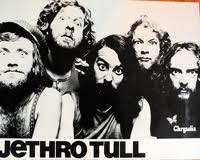
After hitting it big in their homeland with their first three albums, Tull found themselves yearning to find greater success in America, where they had become mildly popular among certain intellectual hippie groups, but still were largely overshadowed by talented acts like The Monkees. Anderson had auditioned over a hundred British guitarists following Abrahams' expulsion from the band, and had settled on a short, balding little man named Martin Barre. True to his name, Barre had the amazing capability to play multiple barre chords on the guitar at the same time, sometimes in completely different areas of the fretboard. While this may seem impossible, the truth is that nobody really cared, because Little Martin's skills on guitar had made Tull a force to be reckoned with.
However, Anderson knew that he had to do something, anything to get the band to conquer America. The inspiration came one night after Anderson's wife came home flustered and shivering in fright, telling Ian that a homeless man with bad teeth, matted hair, and grimy, yellowed fingers had asked for a few pence on the way coming home. This was all Anderson needed. Rushing immediately to his writing lair, he whipped out his acoustic guitar, and promptly began composing the songs for the album that would give his band their first American hit: Aqualung. The album was inspired by a variety of sources including his wife's fantastic story, Anderson's love for diving, and Scottish drinking songs. It was soon recorded in the new Island Records "Record Machine" studio, where Tull was forced to work with Led Zeppelin right next door. Jimmy Page, Zeppelin's conceited lead guitarist, even barged into one of Tull's sessions, messing up Martin Barre's legendary solo on the song "Aqualung" for all time. Thanks, Jim. Finally, the album was released, featuring a nightmare-inducing portrait of a local homeless man and containing songs that instantly became a hit in both the UK and the US. The success was most likely a result of only a few lyrics featured in the album that related to paedophilia.
Tull's success only improved; by the next year they had begun work on the album Thick as a Brick, a one-song epic concept album that was Anderson's attempt to parody other progressive rock bands who thought they were great just because of their own bloated, sophisticated epics. Sadly, the plan backfired entirely. Thick as a Brick ended up turning into the band's first #1 record, and the fact that his majestic attempt at satire had actually been taken seriously would annoy Anderson for the rest of his life. After the success of TAAB (a cool acronym used for no real reason here), Tull followed up with a second concept album that had something to do with hell and dead ballerinas. But by now their supposedly satirical concept albums had already worn everybody out, and the album was met with a well-needed critical beating to calm the band's already inflating egos. After that came a succession of interesting but rather forgettable albums, such as the upbeat Warchild, the muddled and incomprehensible Minstrel in the Gallery, and Too Old to Rock 'n' Roll: Too Young to Die!, which had music critics everywhere scrambling to find a suitable acronym for the album when trashing it in a review.
1977–79: Going folky[edit]
It was around this time that Anderson became interested in writing folkier songs, a decision influenced by his time breeding horses and cats on a newly purchased piece of land in the rolling green pastures of rural England. He dragged Tull back into the studio in 1977 to record the first in a trilogy of folk rock albums: Songs from the Wood. Everyone had been waiting with great anticipation for the newest album from the band, and this release shocked many with its collection of songs about forest creatures, pipers, and silly happenings in the wilderness.
Anderson's next two albums had the same folky vibe, and their ability to transport people's imaginations back to a time when nobility could have sex with dirty commoners in an open valley made them super popular. Anderson later said of the sexual themes and imagery in many Jethro Tull songs: "You may call me perverted for writing a lot of songs like that, but the fact remains that you people really like to listen to them." He then played a single note on his flute (with him at all times), and walked silently away from the interview.
1980–94: Bad '80s pop[edit]
In 1980, after becoming fed up with having to deal with drummers for every single Tull album, Anderson decided to change direction and begin using new technology, in the form of a drum machine. Plus, all the big groups were doing it, and Anderson's fingers needed a well-deserved rest from plucking acoustic guitar strings every year. The public no longer wanted to hear talented minstrels play them lush acoustic pieces; they instead longed for a nice steady beat and Eddie Van Halen guitar solos. So, for the next album, entitled A, everything was electronic. Enlisting the help of a talented keyboardist and programmer, Anderson successfully produced an unusual Tull venture that somehow failed miserably in every way, as well as dividing the band's fanbase into the Folkies, the Brickies (passionate lovers of the Thick as a Brick album and nothing else), and the Electro-boppers, who actually liked the new Tull sound.
Still, this division didn't stop the band from putting out even more electronic albums all through the '80s, until by the start of the '90s even the super-polished computer sound was getting really tiresome. Anderson's long-overlooked drum machine programming saw an unexpected revival during the beginnings of rap music, when artists enjoyed borrowing some of Anderson's drum grooves for their own jams.
1995–present: World music[edit]
Since the mid-90s, the band has taken to specializing in laid-back world music, mainly due to the fact that Ian Anderson's voice has been reduced to a scratchy growl with a half-octave vocal range. This vocal deterioration has long infuriated Anderson, who in his early days was taunted by the likes of Robert Plant for his nasally, sometimes irritating singing voice. Now, he confesses to simply wish for even a trace of that old, golden voicebox he once possessed. He has not quit with the flute solos or guitar playing, however, and the current Jethro Tull lineup consists of a good deal of young blood and new talent, excluding of course frontman Anderson and his trusty right-hand man Martin Barre. As of today, these two have been the longest constant members of Jethro Tull, and are the only ones permitted to tell the public any stories of the good old days of the band.
Live shows[edit]
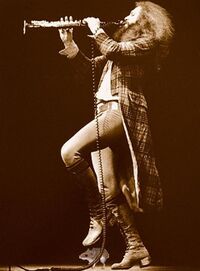
The band is widely known for its eccentric, high-energy live performances. Much of the showmanship for shows is provided by Ian Anderson, who is now widely known as that guy who makes crazy eyes at the camera and jumps around while blowing on a long pipe. But oh, how we love it when he gets up on that stage! During the 1970s, feeling that Jethro Tull was becoming less exciting and original during live shows, Anderson even began wearing a series of custom codpieces to live shows. Boy, did that excite the ladies at the concert, and how it made the guys jealous. Even though Anderson may look back on it now as an old man and wonder, "What the bloody hell was I thinking?", it cannot be denied that he really was an amazing performer, providing wonderful energy and great musicianship all while lugging around a big hunk of metal attached to his crotch.
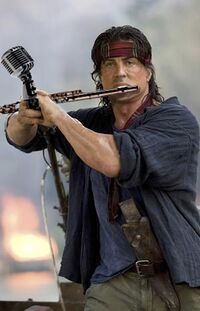
However, the Tull experience was not all about big-haired Anderson (now, sadly, no-haired Anderson). In the background, Martin Barre pounded away at his guitar (or lute, if he was in the romantic mood), and every so often leaped into a solo that made at least twenty audience members explode with pure ecstasy. And keyboardist John Evan desperately tried out silly faces to rival even Anderson's, sometimes coming very close to topping even the frontman's insanity. The drummers of any Tull lineup were always very talented, yet hopelessly under appreciated. Barriemore Barlow, long-time Tull drummer, would appear dressed up as a sailor, floppy hat and all, and then play twenty minute drum solos for a hungry crowd while the rest of a band had a quick tea break. He rarely, if ever, received that much thanks for his duties, but loved it all the same. The bass players weren't anything special, though. They just went dun-dun-dun...dundundun...dun-dun for the show, smiled, and left. What a crazy bunch those Jethro Tull lineups were.
Grammy Award controversy[edit]
As Anderson himself put it, the band ran into "a spot of bother awhile back", more specifically in 1989, when Tull's album Crest of a Knave won a Grammy award for "Best Loud Rock Music", beating the night's favorites Metallica. Since Jethro Tull had been known a long time for its lyrically and musically complex albums, many could not understand why they would beat out the "bump the drums and smash out a bunch of power chords" approach of Metallica. The upset angered the thousands of viewers, fans, and record companies who had always been able to count on knowing who would win what well ahead of time. Not to mention the members of Metallica, who tried to hide their anger behind shrugs and sarcastic comments towards Tull, but still came across as the same old whiny guys they had always been.
None of the members of Jethro Tull had showed up to the awards, at the advice of their producers to avoid embarrassment, but now found themselves even more embarrassed as a result of their win. Thankfully, Anderson's cheeky humor made the situation bearable. The band took out ads in a number of music magazines that proudly stated: Jethro Tull: The World's Up and Coming Heavy Metal Act. It was obviously a joke, yet they were still unsuccessfully sued by Metallica a few days after the ads were published.
Members[edit]
- Ian Anderson: Flute, Soprano Saxflute, Vocals, Questionable Stage Antics, Naughty Lyrics, Audience-Performer Relationship, Acoustic Guitar
- Martin Barre: Electric Guitar, Balding Head
- Barriemore Barlow: Drums, Loud Noises, Floppy Hats
- John Evan: Keyboardist, Crazy Eyes
- Gerald Bostock (unofficial member in 1972): Lyrics, Bricks, Newspaper
- Jeffrey Hammond-Hammond-Hammond-Hammond: Bass Guitar, Grins
- David/Dee Palmer: Orchestral Arrangements, Minstrel Accompaniment, More Keyboards
- Clive Bunker: Elementary drumming, Park benches
- Peter-John Vettesse : Programming, Keyboard, nerdiness
- John Glascock: Bass guitar, Barriemore's BFF

